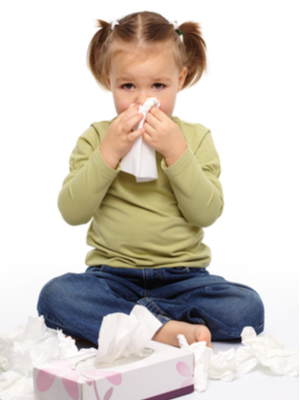Can children outgrow allergies? It’s a reasonable question for you to ask if your child has been diagnosed with an allergy. You want to hope your child won’t always have this chronic condition. The good news is that many children do, in fact, outgrow some of the most common food allergies, for instance to milk, eggs, soy, wheat, nuts, and fish. Environmental allergies to pollen, mold, and dust, on the other hand, are usually not outgrown.
Whether or not your child outgrows an allergy depends in part on what he is allergic to and when the allergy developed. The severity of the reaction also plays a part in whether an allergy will be outgrown. Kids with milk, egg, and soy allergies are more likely to outgrow them and at a younger age than do kids with other allergies. The younger your child is when he develops an allergy, the more likely it is that it will be outgrown. The sad fact is, however, that children who experience severe allergic reactions are less likely to ever outgrow their allergies.
Mayo Clinic’s Nancy Ott, a pediatric allergy and immunization specialist, says that anywhere between 60 and 80 percent of young children will outgrow a milk or egg allergy by age 16. A further 20 percent of children will go on to outgrow a peanut allergy. A small number of children, just 4 to 5 percent, will outgrow a fish or shellfish allergy.

The only safe way to find out whether your child has outgrown a food allergy is to set up a food challenge under a doctor’s supervision. If you bring your child in for a food challenge, expect it to take several hours. During a food challenge, the child is given a small amount of food and watched for a reaction. If all is well, the amount of food given is doubled every 15-30 minutes, until the child manages to eat a full serving without a reaction.
The food challenge is safe because it is performed in a controlled environment. This means that in the event the child has a reaction to the food, the child can be treated on the spot. If there is no reaction, the doctor may decide your child is free to eat that particular food from now on. A food challenge is not recommended for children with severe allergies, because of the risk for anaphylaxis.
What Are Allergies?
An allergy is a physical reaction to something considered harmless to most people. Sometimes the person with allergies is affected by breathing in airborne allergens like dust, mold, or pollen. In other cases, an allergic reaction may be caused by ingesting or eating a certain food, for instance walnuts, a type of tree nut, or tofu which is made from soy. Allergies can also be seasonal, with symptoms appearing only at certain times of the year. A child who is allergic to pollen, for example, may experience symptoms in the spring.

Diagnosing Allergies
Childhood allergies are diagnosed by a doctor. The doctor will take a careful medical history of your child by asking lots of questions and will also observe your child’s symptoms. If the child develops allergy symptoms after eating a certain food, for instance, it’s a good bet the child is allergic to that food. Blood tests can also be helpful in determining whether a child has an allergy, while allergy skin tests can help pinpoint specific allergies. The results of such tests can also help to predict how likely it is that the child will outgrow the allergy.

Allergy Symptoms
Allergy symptoms vary from child to child, but all allergic reactions stem from the same body process. In allergies, the body sees the allergen—the item causing the reaction—as an invader. This sets off a chain reaction in which the white blood cells of the immune system manufacture IgE antibodies. The antibodies glue themselves to mast cells, which trigger the release of powerful chemicals like histamine. The release of these chemicals cause a wide variety of symptoms, including:
- Itchy nose, roof of the mouth, throat, or eyes
- Sneezing
- Stuffy nose (congestion)
- Runny nose
- Tearing of the eyes
- Dark under-eye circles
- Rashes
- Food allergens may bring on vomiting and diarrhea, respiratory symptoms, or even anaphylaxis, which is a severe and life-threatening immediate response to a particular allergen.
In anaphylaxis, there may be hives, swelling of the skin or throat, and stomach symptoms. The airways may narrow and tighten, causing breathing problems. There may be a drop in blood pressure, rapid pulse, and even loss of consciousness. Failure to provide treatment, for instance with auto-injectable epinephrine, may be fatal.

Allergy Treatment
Preventing allergic reactions involves avoiding the allergen or taking medication to prevent an allergic reaction. If the child is allergic to milk, for instance, the child should avoid drinking milk. If the child is allergic to pollen, anti-histamine medication can be helpful in preventing, or at least minimizing symptoms. As mentioned above, a series of allergy shots can help reduce allergic reactions over time. In the case of a sudden allergic reaction, however, an emergency dose of epinephrine may be indicated as a life-saving rescue medication.
Childhood Allergies
Whether reactions are minor or severe, childhood allergies are now so common that they affect up to 40 percent of all children. Of those children who suffer from allergies, a full 8 percent of them have food allergies. Children aren’t the only people to suffer from allergies, of course. A person can develop an allergy at any age, but most people do develop their allergies as children. The good news is that children do indeed, often outgrow their allergies.
Some experts think that children develop a tolerance to allergens as they are exposed to very low levels of substances over time. It’s the reason a series of allergy shots can help to reduce the allergic response to a particular allergen. This process is similar to the way vaccines can immunize us against disease.
While it is reasonable to hope your child may be one of the lucky ones to outgrow an allergy, research shows that the number of child emergency room admissions due to anaphylaxis is rising. One in every five children with a food allergy has had at least one annual food allergy-related emergency room visit. As many as 41 percent of children with food allergies are, as a result, careful to keep their prescription epinephrine shots (Epi-Pen) handy and current, as well they might.
Outgrowing Food Allergies
Do you suspect your child might have outgrown a food allergy? Here is the safe way to find out:
- Speak to your child’s doctor or allergist about the possibility of arranging an in-office food challenge. This will allow the doctor to test the allergen on your child in a controlled environment, where treatment is available in case of a reaction.
- Keep the prescription medications recommended by your child’s doctor in case of reaction, for example auto-injectable epinephrine or diphenhydramine (Benadryl), on hand and current.
- Maintain an ongoing conversation with your child to ensure he or she knows what to do in case of an allergic reaction.
- Remember that while some children do outgrow food allergies, it depends in part on the type of food allergen, when your child developed the allergy, and the level of severity of the allergic reaction experienced.
Food Intolerance
It is common to confuse a food intolerance with a food allergy. In food intolerance, the food may cause stomach distress, but that’s about it. The symptoms come on gradually, go away over time, and aren’t that severe. Doctors generally don’t offer testing for a food intolerance. But there is one severe form of food intolerance that does require evaluation and that is for something called food protein-induced enterocolitis syndrome (FPIES). While severe, most kids do outgrow FPIES.
In the case of a true food allergy, the culprit can be any kind of food. Some foods, however, are known to more often cause allergic reactions than others. Some of the most common food allergies are those most likely to be outgrown by the time kids are in their late teens. Food allergies that tend to be outgrown include allergies to milk, eggs, soy, and wheat.
As many as 60-80 percent of young children with allergies to milk or eggs have no problem with these foods by the time they are 16. Sometimes the form in which the food is served can make a difference. Some kids who are allergic to milk or eggs can have them baked into a cake, cookie, or muffin, with no discernible allergic reaction. Where this is the case, it’s a positive sign that the child will be able to handle eating a plain egg or drink a glass of milk without a reaction at some future point in time.

Allergies to other foods seem to be harder to shake. Kids who are allergic to peanuts, tree nuts, fish, and shellfish, may never outgrow their allergies. And then too, these common food allergens are more likely to cause a more severe reaction.
Only some 20 percent of children who are allergic to peanuts will outgrow the allergy. Kids with tree nut allergies are even less likely to grow out of the allergy, at a rate of only 14 percent. The least likely allergy to be outgrown is one to fish or shellfish. Only some 4-5 percent of children will ever be able to eat these foods, free of reaction.
Not all children have allergies all through childhood, of course. According to at least one study, over one-quarter of children—some 26.6 percent—will outgrow their allergies by the average age of 5.4 years old. The same study found that some of the factors that contribute to outgrowing an allergy include being allergic to just one food, having mild to moderate reactions, and having eczema as the lone allergic symptom. Black children were found to be less likely to outgrow an allergy, compared to white children. Boys were more likely than girls to outgrow an allergy.
Environmental allergies, on the other hand, seem to be even more difficult to kick. Dr. Andrew Dang, a pediatric allergist and immunologist, says allergies to pollen and mold typically develop in children after 2 years of age, as several seasons need to be experienced first before such allergies develop. Allergies to indoor allergens, like dust and pet dander, on the other hand, can develop at a younger age given more chronic year-round exposure. “Environmental allergies are usually not outgrown, with one study showing only 10% of children had their symptoms of environmental allergies completely disappearing, 8-11 years after initial diagnosis,” says Dr. Dang.
Beyond asking the question of whether and when your child will outgrow an allergy, parents need to deal with the here and now. If your child has a food allergy, you will want to develop a good working relationship with a doctor who specializes in childhood allergies. This is the appropriate expert to help you both monitor and manage your child’s food allergies over time.
If you think your child may be experiencing anaphylaxis, call 911 or get to the nearest emergency room, immediately.
Found what you just read useful? Why not consider sending a donation to our Kars4Kids youth and educational programs. Or help us just by sharing!
